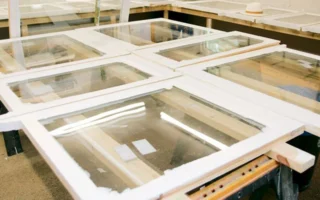The history and evolution of window panes
Window panes have come a long way from their humble beginnings. In ancient times, windows were just openings in walls to let light in and keep the elements out. In the Roman Empire, glass was used to cover these openings, allowing for better insulation and protection.
Over the centuries, window pane technology evolved as advancements in materials and manufacturing processes were made. From single-pane windows to double-glazed and even triple-glazed options, the evolution of window panes has been driven by a constant pursuit of improved energy efficiency and durability.
In recent years, modern advancements like low-emissivity coatings and gas fill between panes have further enhanced the performance of window panes. These innovations not only help with insulation but also contribute to reducing energy costs for homeowners.
The history and evolution of window panes showcase how this essential component of our homes has continuously adapted to meet our changing needs and standards over time.
Different types of window panes (single, double, triple)
Single-pane windows consist of a single layer of glass, offering essential insulation and noise reduction. They are simple in design but may not be as energy-efficient as other options.
On the other hand, double-pane windows have two layers of glass with space in between filled with gas for better insulation. These windows help maintain indoor temperature and reduce energy costs.
Triple-pane windows take it up a notch by providing three layers of glass, offering maximum thermal efficiency and soundproofing properties. They are ideal for areas with extreme weather conditions or high noise levels.
The purpose of a window pane: insulation and protection

Insulation and protection play crucial roles in residential and commercial settings regarding the purpose of window panes. Window panes are not just glass barriers; they are designed to keep indoor spaces comfortable by providing insulation against external temperature changes. The right window pane can help maintain a consistent indoor climate during hot summers or chilly winters, reducing energy costs.
Window panes offer protection from elements like wind, rain, and dust. They shield your home or office interior, allowing natural light to illuminate the space. With technological advancements, modern window panes have features that enhance their insulating properties and durability.
You can optimize their effectiveness in providing insulation and protection by choosing the appropriate materials for your window panes, such as wood, vinyl, or insulated glass. It’s essential to select high-quality window panes that suit your specific needs to ensure optimal performance year-round.
How different materials affect the purpose of a window pane (wood, vinyl, glass)
Wooden window panes are known for their classic aesthetic appeal and natural insulation properties. They provide excellent thermal efficiency, helping to keep your home warm in winter and cool in summer. Wood requires more maintenance than other materials due to its susceptibility to rotting and warping over time.
Vinyl window panes are low-maintenance and durable. They offer good insulation but may not be as aesthetically pleasing as wood or glass. Vinyl is also resistant to moisture damage, making it ideal for high-humidity areas.
Glass window panes are versatile and widely used due to their transparency, allowing natural light to enter a space. Depending on the type of glass used (single, double, or triple-pane), they can offer varying degrees of insulation and noise reduction.
Each material has unique characteristics that influence the effectiveness of a window pane in providing insulation, protection, and overall comfort within a space.
Modern advancements in window pane technology

With the rapid advancement of technology, window panes have also seen significant improvements in recent years. Modern window pane technology advancements have revolutionized how we think about windows.
One of the most notable advancements is the development of bright windows that can change their tint based on sunlight exposure or temperature. These dynamic windows enhance energy efficiency and provide greater comfort and convenience for homeowners.
There has been a surge in using low-emissivity coatings on window panes to reduce heat loss during winter and minimize heat gain during summer. This helps maintain a consistent indoor temperature while lowering energy bills.
Innovative manufacturing techniques have allowed the production of more robust and durable window materials like fiberglass and composite frames. These materials offer increased insulation properties while being eco-friendly.
Modern advancements in window pane technology continue to push boundaries and offer exciting new possibilities for enhancing aesthetics and functionality in our living spaces.
Common issues with window panes and how to fix them
Common problems like drafts, condensation, or cracks can affect the functionality of your windows. Drafts are often caused by gaps around the window frame, which can be sealed using weather stripping or caulk. Condensation on the inside of windows is a sign of high humidity levels – using a dehumidifier can help alleviate this issue.
Cracks in window panes can compromise insulation and pose safety risks. Small cracks can be repaired with glass epoxy or silicone sealant, while larger ones may require professional assistance for replacement. Proper maintenance and regular inspections prevent these common issues from escalating.
Ensuring your window panes are in good condition enhances energy efficiency and prolongs their lifespan. Stay proactive in promptly addressing any concerns to keep your windows functioning optimally for years.




